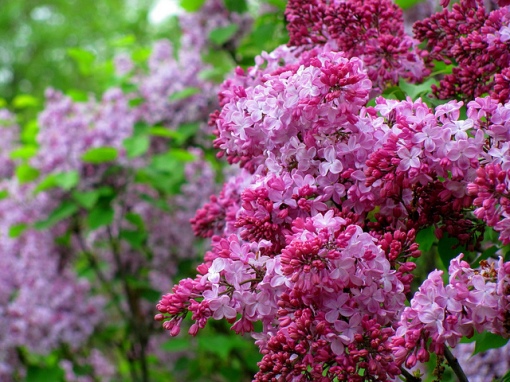
Humans have admired lilacs like these for centuries. Photo by RichardBH. CC. https://www.flickr.com/photos/rbh/5769371225/
Lilacs were part of my childhood. We had a lilac bush in my front yard, and the week that it was in bloom I would rush outside and bury my face in its light purple flowers. In Calgary, where the growing season starts quite late, the lilacs always bloomed around exam time in mid-June. For me they were a symbol that spring had finally arrived and that school would soon be over.
I’m a biology nerd and I love how plants work. However, I’m also fascinated by how plants interact with humans. For this post, I’m going to examine lilacs from the biological, and then a cultural perspective, just to see what happens. Here we go.
Botany:
Lilacs are part of the olive family. There are 21 species of lilac. Most of them come from China, and 2 come from Eastern Europe. They do well in Canada because they are good at surviving in cold climates. In fact, they need a cold dormant period to trigger blooming!
A newly planted lilac won’t bloom for a few years, because it’s getting used to the new environment. Once it is well established and comfortable, then it will start flowering.
Human interactions:
Just like the dandelion, in North America the lilac is an alien invader. They are native to China and Eastern Europe, so how on earth did they get to Canada?
Well, it’s a VERY long story.
A bizarre story about humanity’s obsession with pretty purple flowers.
Which when you think about it, is a pretty strange obsession.
Okay, lilacs do have some practical uses. Green dye can be extracted from the flowers and leaves, and oils from the flowers are used in perfumes. They have also been used as treatments for sore mouth, stomach ache and paralysis.
But mostly, people like them because they look and smell nice.
Our story begins in the European Baltic states, the native stomping grounds of the European lilac. Shepherds, entranced by the beauty and aroma of the wild plant, brought lilac bushes back to their homesteads. These lilac flowers were light purple. The word lilac comes from Persian, and means ‘blueish’.
Eventually lilacs made their way to Instanbul via the silk trade routes. Apparently someone thought they were valuable enough to trade.
In 1563, and Austrian ambassador visiting Instanbul fell in love with lilacs and brought them back to Austria and then later to Paris.
Once introduced to the people of France, lilacs spread around Europe like a fluffy purple disease. They moved from garden to garden as people shared cuttings with their neighbors.
Around 1650, European immigrants brought lilacs to North America in their personal luggage. Lilacs quickly adapted to the cold, temperate climate and soon become a common sight in North American colonies. Even Thomas Jefferson and George Washington planted lilacs in their gardens.Eventually, lilacs in North America escaped from cultivation and became a part of the natural environment.
Remember how I said that most lilac species come from China? Well, prior to 1860 most Europeans had never seen them because China had a closed-door policy on trade. However, when China lost the Opium wars and was forced to trade with Europe, lots of Chinese lilac species were ‘discovered’ by Europeans. Enraptured European plant explorers sent home thousands of ‘new’ species, including lilacs.
Compared to this influx of Chinese lilacs, the wild European lilac was staring to look positively drab. In the 1770s people in Europe, wanting flashier colours, started breeding deep purple and white lilacs.
In 1871 in Nancy, France, Victor Lemoine decided that the wild lilacs were simply not interesting enough. He and his family created 200 different lilac cultivars of all different colours and shapes. A cultivar is a variety of plant made artificially by humans. Think of cultivars like dog breeds. A poodle and a bull dog belong to the same species, but they are different forms that humans have created through breeding. Thanks to Lemoine, France became the hub of fine lilac cultivars.
Today there are over 1500 lilac varieties! Compare that to the original 21 species.
Back in North America, people started breeding their own cultivars. In 1874 John Dougall of Windsor Ontario created the first North American cultivar called ‘White Princess Alexandra’. Yay Canadian pride!
In 1878, not content with breeding new cultivars, lilac breeders started combining species from China and Europe that never would have reproduced in the wild. Combining two species like this is called hybridization.
Thankfully for plants, sex between different species isn’t that big a deal. It actually happens quite frequently because the barriers between plant species are much fuzzier than in animals.
Finally, the Canadian Connection! Isabella Preston, the first female hybridizer in Canada, put Canada on the lilac map in 1920. Preston produced the ultimate lilac for Canada’s harsh climate by crossing Chinese lilacs. And she did her work right here in Ottawa, at the Central Experimental Farm! This un-sung Canadian horticulturalist also created Canada-friendly cultivars of roses, lilies, crab apple, and iris.
For anyone living in Ottawa, there is a whole website about lilacs at the Central Experimental Farm, including the best places to find them.
After doing this research, I realized that there are a lot of people throughout history who really cared about lilacs. It was their jobs to make new cultivars to sell to people. Also, people liked lilacs enough to carry them across trade routes and across oceans. Not bad for a hardy little bush with purple flowers!
References:
http://alpenglowlilacgardens.com/index-2.html
http://www.britannica.com/EBchecked/topic/340948/lilac
http://www.friendsofthefarm.ca/lilacs/lilachistgenus.htm
http://arboretum.harvard.edu/plants/featured-plants/lilacs/plants-of-history-plants-for-tomorrow/
http://www.nh.gov/lilacs/lilacs/
http://www.science.ca/scientists/scientistprofile.php?pID=280

